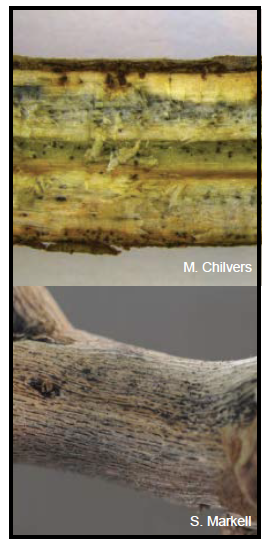
Fact Sheets And Publications
Charcoal Rot in Soybean
Charcoal rot of soybean can be a major yield-robber of drought-stressed soybeans in Delaware. The disease is caused by Macrophomina phaseolina, a common soil-borne fungal pathogen that inhabits much of Delaware’s agricultural soils. This article will explain how to properly identify the disease, review its disease cycle, and outline management options.

Disease Identification
Signs and symptoms typically manifest late in the year when soybeans have reached reproductive maturity and symptoms usually do not appear unless plants are heat or drought stressed. Symptomatic plants generally appear in spots of the field that are moisture limited, such as high spots or compacted headlands. Plants may be stunted, wilted, bearing abnormally small leaves that turn chlorotic and necrotic but remain attached to the plant. Roots and stems near the soil surface of infected plants will appear gray with tiny black specks or dots (resembling charcoal dust) on the tissue surface or just inside the stem (figure 1). The presence of black lines/zones within the stem may or may not occur.
Disease Cycle
M. phaseolina persists in the soil as tiny black survival structures called microsclerotia. These structures are recalcitrant and can survive in dry soil for over 2 years, but only for a couple of months in saturated soil [1]. Microsclerotia will germinate in the spring in the presence of a host. The pathogen colonizes young soybean roots, typically within the first few weeks after planting. The fungus remains in the plant throughout the growing season, during which time the pathogen will remain latent and soybeans will not likely show signs of infection. As the soybeans reach reproductive stages and soil moisture becomes low and plants become heat and drought stressed, the fungus starts to grow more rapidly and colonizes the water-conducting tissues of the plant. This causes wilting, stunting, necrosis, and premature death of entire plants. The pathogen then overwinters as microsclerotia in the soil or in infected plant debris.
Management
Managing charcoal rot can be difficult due to the fact that M. phaseolina has a host range of over 500 plant species, many of which are weeds and common agronomic crops [2]. In addition, foliar fungicides and seed treatments are ineffective at managing the disease. A combination of good management practices should be utilized that reduce plant stress and promote healthy soybean growth.
Crop Rotation
Crop rotation has a modest impact on managing this disease because of its survivability and large host range, which includes most major agronomic and vegetable crops commonly grown in Delaware (see table 1). Rotating away from soybean for at least one year may help. Cereal grains are good crops to plant in rotation for managing this disease, as well as corn and sorghum, as they are relatively poor hosts under normal growing conditions. Avoid growing soybean or other bean crops back-to-back in problematic fields.
| Common Name | Genus |
|---|---|
| Mustard | Brassica |
| Pepper | Capsicum |
| Watermelon | Citrullus |
| Cucumber, muskmelon, and cantaloupe | Cucumis |
| Gourd, squash, zucchini and pumpkin | Cucurbita |
| Strawberry | Fragaria |
| Soybean | Glycine |
| Sunflower | Helianthus |
| Alfalfa | Medicago |
| Bean (including snap and lima) | Phaseolus |
| Pea | Pisum |
| Tomato, potato and eggplant | Solanum |
| Sorghum and sudangrass | Sorghum |
| Clover | Trifolium |
| Vetch | Vicia |
| Corn | Zea |
Irrigation
Charcoal rot has a severe impact when plants become heat and drought stressed. Therefore, use irrigation if it is available, especially if plants begin to show signs of water and heat stress during flowering and pod development.
Soil Fertility and General Plant Health
It is important to keep soybeans healthy and reduce the amount of stress as much as possible. Ensure your fertility levels are optimum, but avoid over-fertilization and high plant populations, as these conditions will stress plants.
Variety Selection and Planting
There are no soybean varieties that have complete resistance to the pathogen; however, planting dates and maturity groups can be used in your favor. Early maturing full-season soybeans (groups II, III, and some IV) are generally more severely affected by charcoal rot because they are planted earlier and tend to set pods during the driest part of the summer. Double cropped soybeans flower later and generally avoid the hot, dry summer weather and thus avoid drought stress that brings on severe charcoal rot symptoms. Microsclerotia can survive in small cracks on seed, so be sure to plant certified seed.
Tillage
Tillage practices will have a small impact on this disease, but a no-till or reduced tillage cropping system can increase soil moisture and reduce drought stress. Be aware that plowing can bring microsclerotia buried deep in the soil to the surface, which can serve as inoculum. Compacted soils will exacerbate drought conditions and amplify yield loss caused by charcoal rot, so consider sub-soiling or other management options to alleviate or reduce soil compaction.
References
1. Smith, D., Chilvers, M., Dorrance, A., Hughes, T., Mueller, D., Niblack, T., Wise, K. 2015. Charcoal rot. Soybean Disease Management. Crop Production Network.
2. Sinclair, J. 1984. Compendium of soybean diseases, 2nd edn. American Phytopathological Society, St. Paul, Minn.
3. Smith, D., Chilvers, M., Dorrance, A., Hughes, T., Mueller, D., Niblack, T., Wise, K. 2014. Charcoal rot management in the north central region. University of Wisconsin Extension.
UD Cooperative Extension
This institution is an equal opportunity provider.
In accordance with Federal law and U.S. Department of Agriculture policy, Cooperative Extension is prohibited from discriminating on the basis of race, color, national origin, sex, age, or disability.
